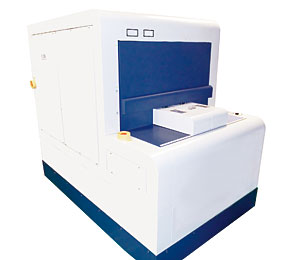SCREEN Holdings and Osaka University Successfully Produce Solar Cell Evaluation System Utilizing Terahertz Technology
Installed at Fukushima Renewable Energy Institute to Contribute to Cutting-edge Solar Cell Research and Development
Kyoto, Japan - March 6, 2015 - SCREEN Holdings Co., Ltd. and Osaka University have announced the successful production of a solar cell evaluation system equipped with laser terahertz emission microscope (LTEM) technology*. This system enables the measurement and visualization of the instantaneous electrical generation of a solar cell. It is to be installed at the Fukushima Renewable Energy Institute**, a globally renowned R&D center, to support cutting-edge solar cell research and development.


In recent years, the worldwide use of renewable energy has advanced toward the goal of realizing a low-carbon society. As a distinctive method of utilizing renewable energy to produce electricity, the application of photovoltaic power generation is expected to spread even further in the future. However, one of the challenges with crystalline silicon solar cells, which account for approximately 80% of all commercial solar cells produced, is in the various ways that energy is lost during power generation. For this reason, if the impact of the instantaneous changes in electricity generation on energy conversion and loss can be verified, it is expected to stimulate research into improving generation efficiency.
In October 2011, SCREEN Holdings and Osaka University used LTEM technology to measure the terahertz waves*** that are generated by a solar cell and, for the first time, successfully visualized the changes in instantaneous electrical generation for the extremely short time of one trillionth of a second, as an effective way of demonstrating this theory. We have since been conducting research and development toward the practical application of this technology. Amid growing expectations on the part of domestic and foreign researchers and engineers for the utilization of this technology in solar cell analysis and substantive experiments, we have now realized the production of a solar cell evaluation system that employs our LTEM technology. The system will be installed at the Fukushima Renewable Energy Institute, a leading R&D center for the renewable energy sector.
As well as contributing through this initiative to overall research and development in the field of solar cells at the Fukushima Renewable Energy Institute, SCREEN Holdings and Osaka University will be applying the know-how accumulated during this research with the goal of developing new areas that take advantage of terahertz wave detection and analysis technology.
■ Comment by Hidetaka Takato, Photovoltaic Power Team Leader
Renewable Energy Research Center, Fukushima Renewable Energy Institute, AIST
At our center, we are advancing technological development that targets the realization of reliable, high-efficiency crystalline silicon solar cells and modules. In the development of these solar cells, it is important to elucidate the mechanisms for operational analysis and reliability at the time of power generation. The solar cell evaluation system developed by SCREEN Holdings and Osaka University is expected to make a significant contribution to improvements in conversion efficiency. Using this system, it is possible to visualize and measure a cell's internal state, something that could not previously be confirmed. I have great hope that research and development into solar cells will accelerate through the use of this system.
* Laser terahertz emission microscope (LTEM)
A terahertz wave application analysis system developed by Professor Tonouchi of the Institute of Laser Engineering, Osaka University. An LTEM system illuminates semiconductors, superconductors, and ferroelectric and other materials and devices with laser pulses for an extremely short time of around 100 femtoseconds and visualizes the generated terahertz waves. (1 femtosecond equals 1 quadrillionth of a second.)
** Fukushima Renewable Energy Institute, National Institute of Advanced Industrial Science and Technology
The institute was opened in Koriyama, Fukushima Prefecture in April 2014. Its main missions are "The promotion of R&D into renewable energy, which is open to the world; and to make a contribution to industrial clusters and reconstruction." The institute was established as a novel research base to produce and transmit new technologies for renewable energy in collaboration with domestic and international partners.
*** Terahertz waves
This refers to a wave frequency in the terahertz range (1 tera equals 1 trillion). The electromagnetic waves have a frequency range from around 100 GHz to 30 THz that corresponds to wavelengths from 3 mm to 10 μm.
Notes:
- This joint development received a subsidy for "advanced technology demonstration and evaluation facility development" under the Innovation Center Establishment Assistance Program of the Ministry of Economy, Trade and Industry. We are also making use of the Adaptable and Seamless Technology Transfer Program through Target-driven R&D, the JST, and the Ministry of Education, Culture, Sports, Science and Technology's Project for Creation of Research Platforms and Sharing of Advanced Research Infrastructure initiative.
- This technology will be announced on March 13 (Friday) at the "Bulk, thin-film and other silicon-based solar cells" session of the 62nd JSAP Spring Meeting(http://meeting.jsap.or.jp/eng/), which will be held from March 11 (Wednesday), 2015 at Tokai University's Shonan Campus.